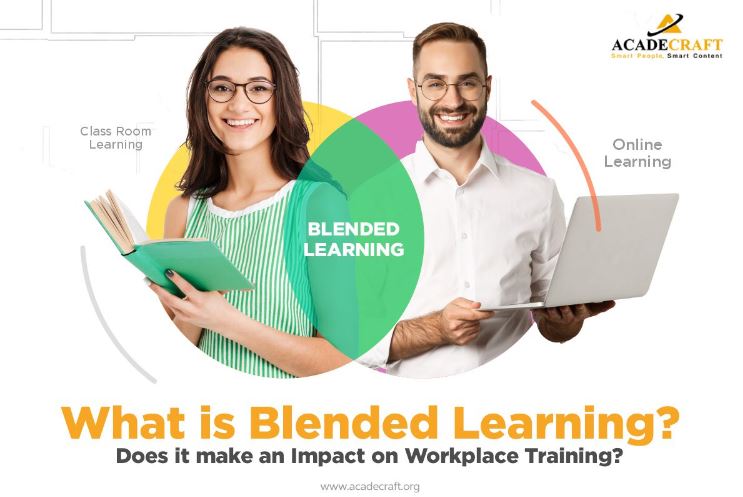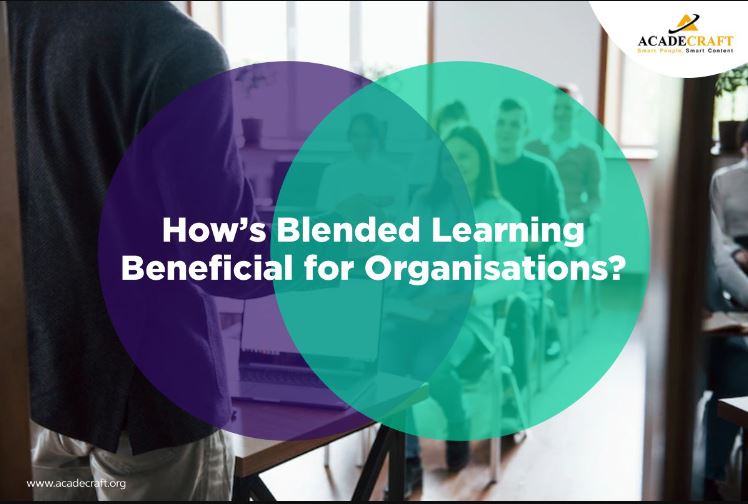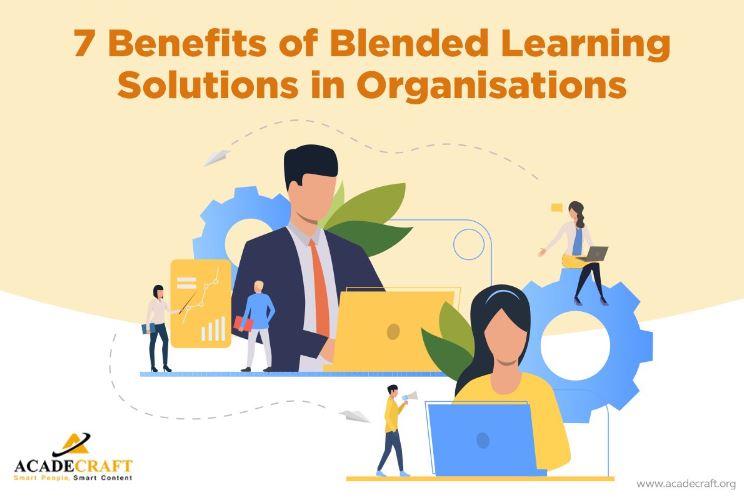What’s new in the educational sector these days? Have you heard about the rapid rise of blended learning solutions? Digitization has brought about numerous revolutions in the education industry. Blended learning is one of them.
But did you know blended learning has become a major hit in the organisational sectors as well?
Though popular globally, people are ignorant about the myriad benefits of blended learning in the workplace. This is what we are here for!
In this blog, you’ll know about:
- What is Blended Learning?
- Types of Blended Learning
- How does Blended learning benefit organisations?
Without further delay, let’s head on to the informative journey of blended learning.
What is Blended Learning?

Blended learning, in simple terms, is the combination of both online and offline learning. To fit in the present scenario of learning needs, blended learning blends both the traditional and learning methods.
For example, learners can access the resources both in online and offline methods if a learner wants the theoretical aspect online and the practical element physically, it’s possible.
Blended learning solutions offer personalised learning along with face-to-face interaction. Hence, with blended learning, you have benefits both ways.
People often have this confused with blended learning. Let’s clear it once and for all! Blended learning isn’t here to replace or complement traditional learning styles. But, blended learning is in the scene to make the educational path personalised and effective for learners.
According to a survey, blended learning has generated better learning outcomes than other learning styles.
Types of Blended Learning

Blended learning has various types. Let’s talk about the most common types of blended learning.
Flipped Model
The name says it all! In the flipped model, the traditional role in learning gets inverted. This model of education focuses on online learning. Here, learners can consume the content according to their flexible timings. The flipped model allows learners to prioritise active learning during class time.
Rotational Model
The rotational model allows learners to rotate through online self-paced and face-to-face learning. Though the schedules are fixed, it is flexible.
In this model, learners of the same group rotate among different tasks and exercises. Here, everyone takes an equal part in activities.
There are four types of rotational model blended learning solutions:
- Station Rotation
- Lab Rotation
- Flipped Rotation
- Individual Rotation
Face-to-Face Driver Model
This type of blended learning is the closest to the traditional structure. In this process, the learning happens online, with the assignments and tasks being set later. It is easy to deliver this learning model using a Learning Management System (LMS).
Enriched Virtual Model
Online training is the primary component of the enriched virtual model. It is one of the most popular forms of blended learning in the era of remote work.
Here, the learners go through a scheduled instructor-led classroom session in virtual or physical classrooms.
Flex Model
The flex blended solution model gives learners a flexible and personalised experience. The model ensures to cater to the learners’ needs precisely.
Here too, the online mode of learning takes the driver’s seat while the trainers and instructors provide the needed support.
The flex model follows a learner-centric approach where learners can customise the paths and follow the schedules throughout the learning process.
These are some of the most common types of blended learning solutions. Aren’t you eager to know about the multiple benefits in the workplace?
Let’s take a look!
How Does Blended Learning Solutions Benefit Organisations?
A recent survey states that the corporate learning market size will grow at a CAGR of 11.8% by 2028. Moreover, another report says that employees prefer blended learning to other forms of learning.
What makes blended learning the most preferable among the employees? Let’s see.
Employee Engagement
Employee engagement is one of the primary aspects of a productive workforce. But, reports suggest that a human being’s attention span is lesser than a goldfish’s!
So, what can employers introduce to improve the engagement of learners? Blended learning is one of the best solutions.
Companies can use various online learning methods like webinars to record training sessions. Moreover, with tactics like gamification and other innovative ideas, the online part of blended learning can bring in exciting results.
Creative modules will result in better engagement from the learners’ end. This will help in building a productive workforce.
Improved Flexibility
With blended learning solutions, learners can strike a balance and have consideration for their non-training workload.
The blend of offline and online training allows employees the flexibility they want! For example, if employees feel the course’s pace is too fast, they can hit the pause button!
Employees can leverage the best benefits with the blended learning modules. If they have issues understanding a specific topic, they can directly ask the instructors to help.
Employees can learn from the comfort of their homes and also from a disciplined setting of an office. It’s all on the learner.
From the space to the pace of learning, blended learning is a hit in all!
Boosts Productivity and Morale
Do you know what the result of improved engagement and flexibility is? A better and more productive workforce. Isn’t that the ultimate aim of every organisation?
Providing freedom and flexibility goes a long way in satisfying the employees. Companies using blended learning solutions entail a trust in employees to take charge of their learning.
This step ensures a productivity improvement and also boosts the employee’s morale.

Caters to the Employee’s Needs
It is the 21st century today! The millennial and Gen Z learners don’t believe in the one-size-fits-all learning approach. With blended learning, the learning approach becomes personalised.
Blended learning solely focuses on the learners’ needs. It combines online and traditional education and customises training needs to meet employees’ skills and knowledge.
With blended learning, companies can set up channels that cater to each employee’s learning style and requirements. The developers can present the customised training programs in different formats catering to the learning goals of employees.
With the customised training needs, employees can find their required information through webinars, ebooks, resources, and others.
Improves the ROI
With blended learning solutions, the ROI also sees an immense improvement. Blended learning reduces training costs. Moreover, it saves time for employees, cutting down the travel time, resulting in improved productivity.
Online learning isn’t free of cost, but developers can keep it low cost by option the various access technologies available today.
This, in turn, improves the return on investment for companies.
Improves Retention
Innovative and exciting content always stays in mind. With blended learning, organisations ensure that the learning methodologies retain in the learners’ memory.
Companies can reach various employees with blended learning, from visual to kinesthetic learners. With innovative and flexible learning, the blended model strongly impacts learners’ minds.
Tracks Progress
Every employer needs to know the progress report of the employees. This helps them understand every individual’s pain points and strengths.
With blended learning solutions, this is an easy possibility. Companies can track the learner’s progress and improve the learner’s understanding of various concepts.
Blended Learning Solutions: A Better Opportunity for Workplace Training
Blended learning is one of the most popular forms of learning in today’s world. The blend of both online and offline courses has resulted in better education and better training.
Acadecraft is one of the best options for organisations wanting to hire a blended learning solution provider. A single blended learning module can reap maximum benefits to help learners from various companies.




